MGT737 - Analyzing Supply Chain Management at Starbucks
VerifiedAdded on 2023/06/11
|10
|2187
|341
Report
AI Summary
This report provides an analysis of Starbucks' supply chain management, examining the industry context, company overview, and specific issues the company faces. It identifies three key challenges: changing customer preferences, illegal and unethical practices within the supply chain, and sustainability concerns. The report delves into how these issues impact Starbucks' operations and brand image. Furthermore, the report offers recommendations for addressing these challenges, including conducting continuous market surveys to align with customer preferences, taking strict actions against suppliers involved in unethical practices, and strengthening sustainability efforts through farmer education and waste recycling. The analysis emphasizes the importance of a robust and ethical supply chain for maintaining Starbucks' competitive advantage in the global market. Desklib offers a wealth of similar solved assignments and past papers for students.
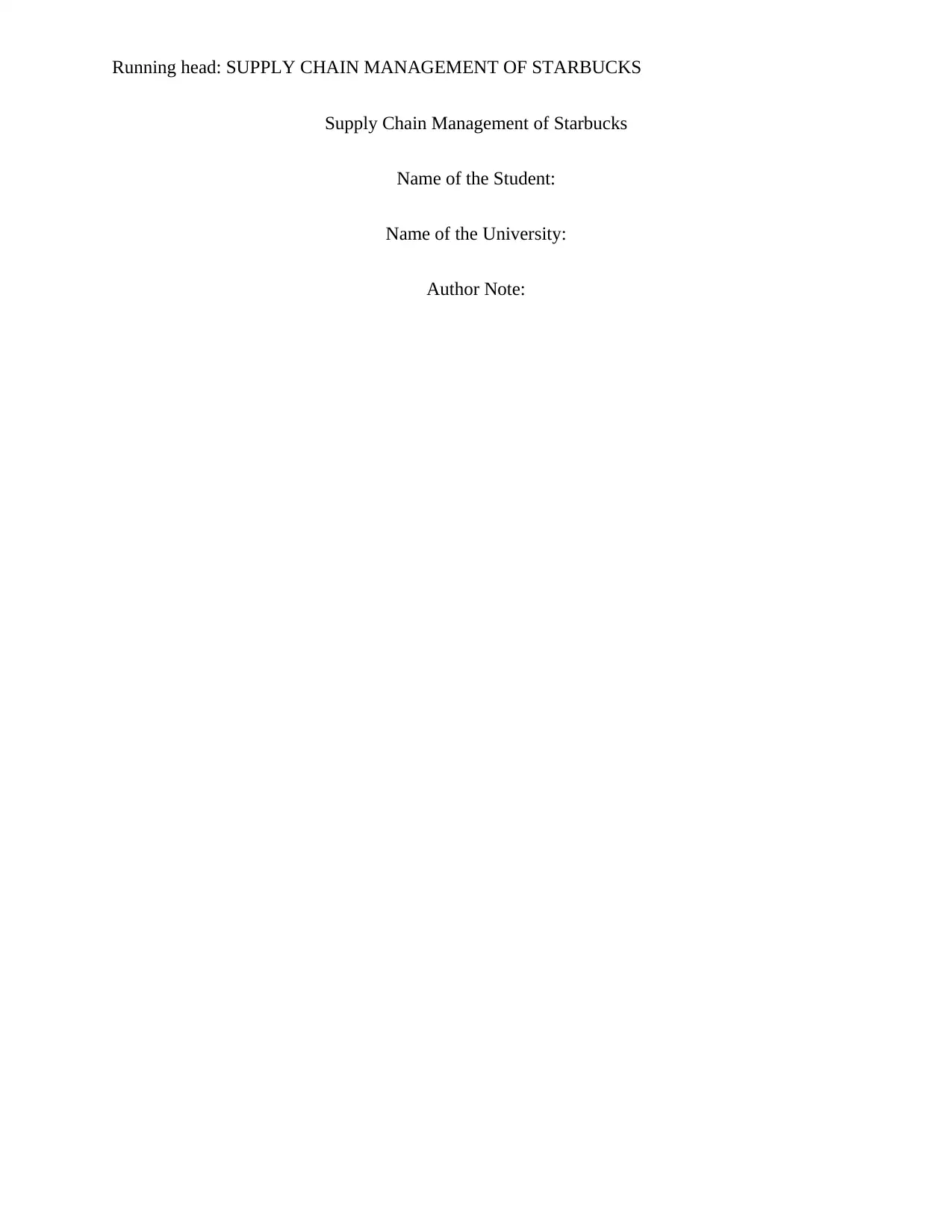
Running head: SUPPLY CHAIN MANAGEMENT OF STARBUCKS
Supply Chain Management of Starbucks
Name of the Student:
Name of the University:
Author Note:
Supply Chain Management of Starbucks
Name of the Student:
Name of the University:
Author Note:
Paraphrase This Document
Need a fresh take? Get an instant paraphrase of this document with our AI Paraphraser
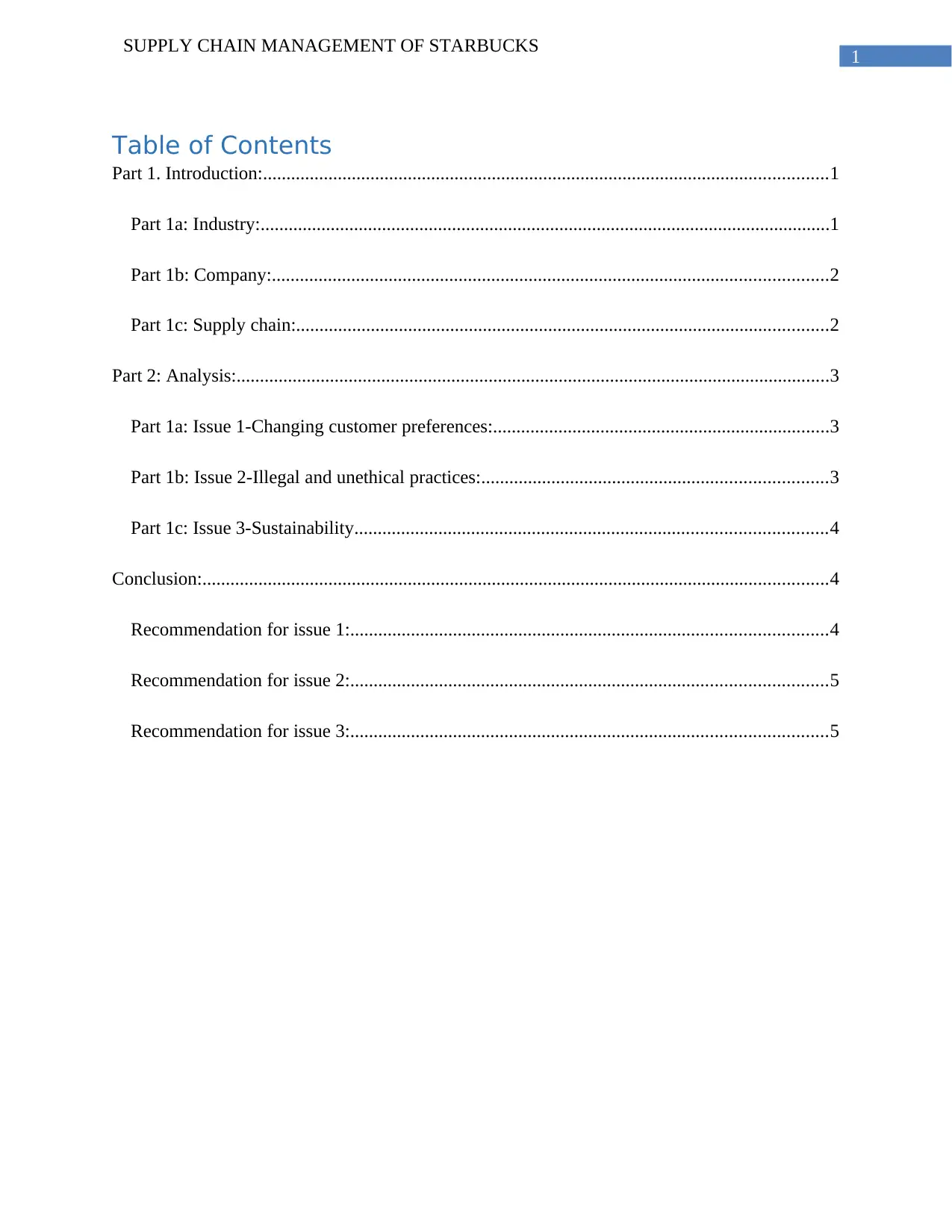
1
SUPPLY CHAIN MANAGEMENT OF STARBUCKS
Table of Contents
Part 1. Introduction:.........................................................................................................................1
Part 1a: Industry:..........................................................................................................................1
Part 1b: Company:.......................................................................................................................2
Part 1c: Supply chain:..................................................................................................................2
Part 2: Analysis:...............................................................................................................................3
Part 1a: Issue 1-Changing customer preferences:........................................................................3
Part 1b: Issue 2-Illegal and unethical practices:..........................................................................3
Part 1c: Issue 3-Sustainability.....................................................................................................4
Conclusion:......................................................................................................................................4
Recommendation for issue 1:......................................................................................................4
Recommendation for issue 2:......................................................................................................5
Recommendation for issue 3:......................................................................................................5
SUPPLY CHAIN MANAGEMENT OF STARBUCKS
Table of Contents
Part 1. Introduction:.........................................................................................................................1
Part 1a: Industry:..........................................................................................................................1
Part 1b: Company:.......................................................................................................................2
Part 1c: Supply chain:..................................................................................................................2
Part 2: Analysis:...............................................................................................................................3
Part 1a: Issue 1-Changing customer preferences:........................................................................3
Part 1b: Issue 2-Illegal and unethical practices:..........................................................................3
Part 1c: Issue 3-Sustainability.....................................................................................................4
Conclusion:......................................................................................................................................4
Recommendation for issue 1:......................................................................................................4
Recommendation for issue 2:......................................................................................................5
Recommendation for issue 3:......................................................................................................5
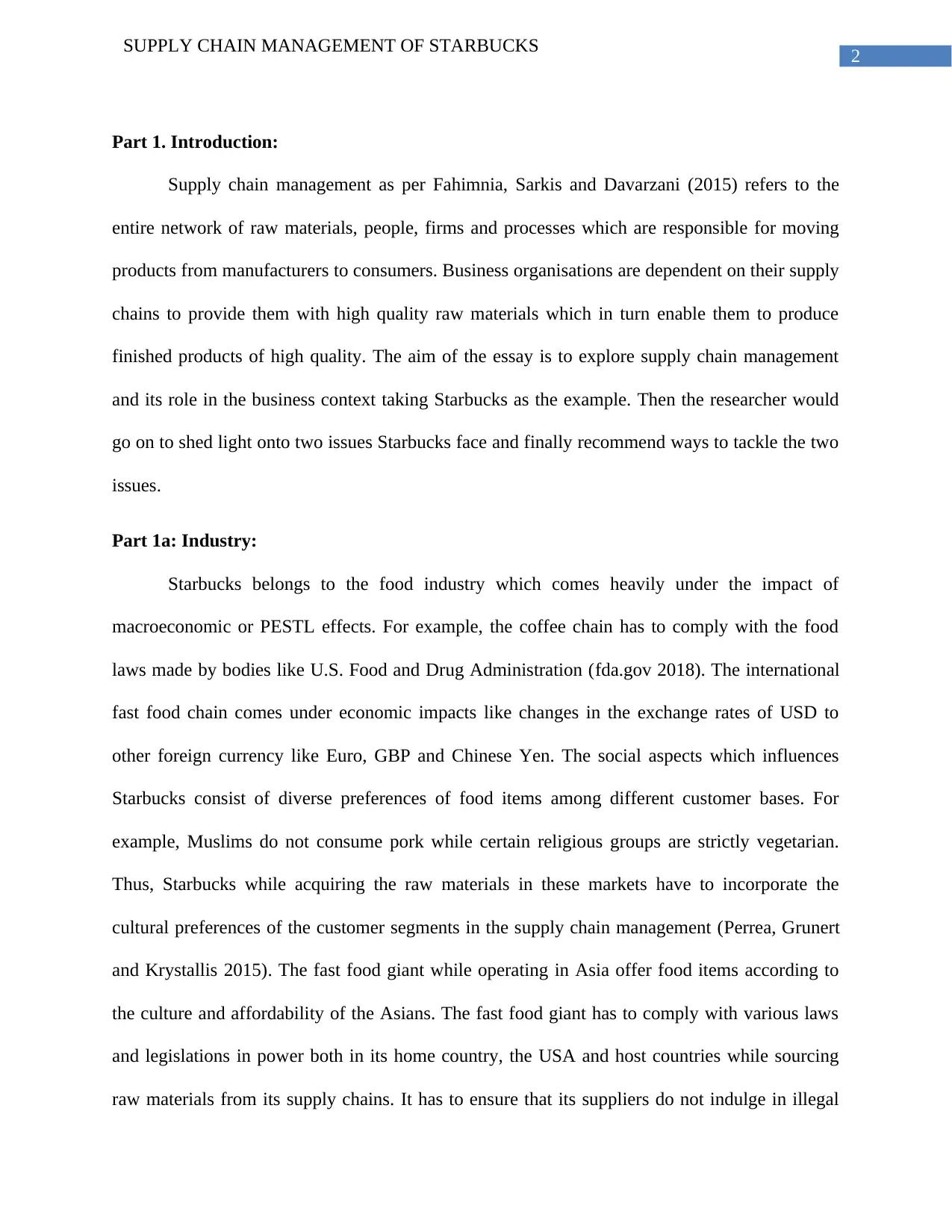
2
SUPPLY CHAIN MANAGEMENT OF STARBUCKS
Part 1. Introduction:
Supply chain management as per Fahimnia, Sarkis and Davarzani (2015) refers to the
entire network of raw materials, people, firms and processes which are responsible for moving
products from manufacturers to consumers. Business organisations are dependent on their supply
chains to provide them with high quality raw materials which in turn enable them to produce
finished products of high quality. The aim of the essay is to explore supply chain management
and its role in the business context taking Starbucks as the example. Then the researcher would
go on to shed light onto two issues Starbucks face and finally recommend ways to tackle the two
issues.
Part 1a: Industry:
Starbucks belongs to the food industry which comes heavily under the impact of
macroeconomic or PESTL effects. For example, the coffee chain has to comply with the food
laws made by bodies like U.S. Food and Drug Administration (fda.gov 2018). The international
fast food chain comes under economic impacts like changes in the exchange rates of USD to
other foreign currency like Euro, GBP and Chinese Yen. The social aspects which influences
Starbucks consist of diverse preferences of food items among different customer bases. For
example, Muslims do not consume pork while certain religious groups are strictly vegetarian.
Thus, Starbucks while acquiring the raw materials in these markets have to incorporate the
cultural preferences of the customer segments in the supply chain management (Perrea, Grunert
and Krystallis 2015). The fast food giant while operating in Asia offer food items according to
the culture and affordability of the Asians. The fast food giant has to comply with various laws
and legislations in power both in its home country, the USA and host countries while sourcing
raw materials from its supply chains. It has to ensure that its suppliers do not indulge in illegal
SUPPLY CHAIN MANAGEMENT OF STARBUCKS
Part 1. Introduction:
Supply chain management as per Fahimnia, Sarkis and Davarzani (2015) refers to the
entire network of raw materials, people, firms and processes which are responsible for moving
products from manufacturers to consumers. Business organisations are dependent on their supply
chains to provide them with high quality raw materials which in turn enable them to produce
finished products of high quality. The aim of the essay is to explore supply chain management
and its role in the business context taking Starbucks as the example. Then the researcher would
go on to shed light onto two issues Starbucks face and finally recommend ways to tackle the two
issues.
Part 1a: Industry:
Starbucks belongs to the food industry which comes heavily under the impact of
macroeconomic or PESTL effects. For example, the coffee chain has to comply with the food
laws made by bodies like U.S. Food and Drug Administration (fda.gov 2018). The international
fast food chain comes under economic impacts like changes in the exchange rates of USD to
other foreign currency like Euro, GBP and Chinese Yen. The social aspects which influences
Starbucks consist of diverse preferences of food items among different customer bases. For
example, Muslims do not consume pork while certain religious groups are strictly vegetarian.
Thus, Starbucks while acquiring the raw materials in these markets have to incorporate the
cultural preferences of the customer segments in the supply chain management (Perrea, Grunert
and Krystallis 2015). The fast food giant while operating in Asia offer food items according to
the culture and affordability of the Asians. The fast food giant has to comply with various laws
and legislations in power both in its home country, the USA and host countries while sourcing
raw materials from its supply chains. It has to ensure that its suppliers do not indulge in illegal
⊘ This is a preview!⊘
Do you want full access?
Subscribe today to unlock all pages.

Trusted by 1+ million students worldwide
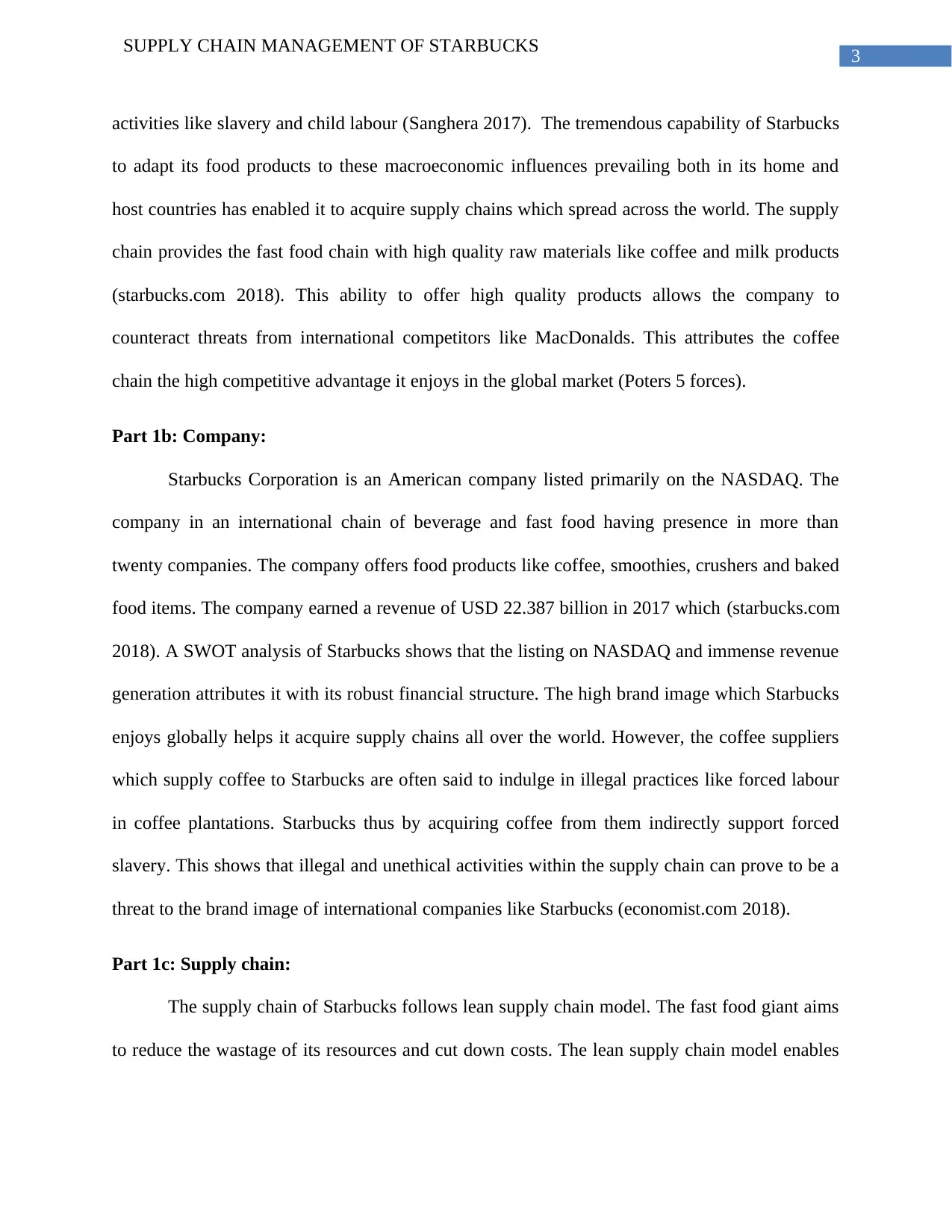
3
SUPPLY CHAIN MANAGEMENT OF STARBUCKS
activities like slavery and child labour (Sanghera 2017). The tremendous capability of Starbucks
to adapt its food products to these macroeconomic influences prevailing both in its home and
host countries has enabled it to acquire supply chains which spread across the world. The supply
chain provides the fast food chain with high quality raw materials like coffee and milk products
(starbucks.com 2018). This ability to offer high quality products allows the company to
counteract threats from international competitors like MacDonalds. This attributes the coffee
chain the high competitive advantage it enjoys in the global market (Poters 5 forces).
Part 1b: Company:
Starbucks Corporation is an American company listed primarily on the NASDAQ. The
company in an international chain of beverage and fast food having presence in more than
twenty companies. The company offers food products like coffee, smoothies, crushers and baked
food items. The company earned a revenue of USD 22.387 billion in 2017 which (starbucks.com
2018). A SWOT analysis of Starbucks shows that the listing on NASDAQ and immense revenue
generation attributes it with its robust financial structure. The high brand image which Starbucks
enjoys globally helps it acquire supply chains all over the world. However, the coffee suppliers
which supply coffee to Starbucks are often said to indulge in illegal practices like forced labour
in coffee plantations. Starbucks thus by acquiring coffee from them indirectly support forced
slavery. This shows that illegal and unethical activities within the supply chain can prove to be a
threat to the brand image of international companies like Starbucks (economist.com 2018).
Part 1c: Supply chain:
The supply chain of Starbucks follows lean supply chain model. The fast food giant aims
to reduce the wastage of its resources and cut down costs. The lean supply chain model enables
SUPPLY CHAIN MANAGEMENT OF STARBUCKS
activities like slavery and child labour (Sanghera 2017). The tremendous capability of Starbucks
to adapt its food products to these macroeconomic influences prevailing both in its home and
host countries has enabled it to acquire supply chains which spread across the world. The supply
chain provides the fast food chain with high quality raw materials like coffee and milk products
(starbucks.com 2018). This ability to offer high quality products allows the company to
counteract threats from international competitors like MacDonalds. This attributes the coffee
chain the high competitive advantage it enjoys in the global market (Poters 5 forces).
Part 1b: Company:
Starbucks Corporation is an American company listed primarily on the NASDAQ. The
company in an international chain of beverage and fast food having presence in more than
twenty companies. The company offers food products like coffee, smoothies, crushers and baked
food items. The company earned a revenue of USD 22.387 billion in 2017 which (starbucks.com
2018). A SWOT analysis of Starbucks shows that the listing on NASDAQ and immense revenue
generation attributes it with its robust financial structure. The high brand image which Starbucks
enjoys globally helps it acquire supply chains all over the world. However, the coffee suppliers
which supply coffee to Starbucks are often said to indulge in illegal practices like forced labour
in coffee plantations. Starbucks thus by acquiring coffee from them indirectly support forced
slavery. This shows that illegal and unethical activities within the supply chain can prove to be a
threat to the brand image of international companies like Starbucks (economist.com 2018).
Part 1c: Supply chain:
The supply chain of Starbucks follows lean supply chain model. The fast food giant aims
to reduce the wastage of its resources and cut down costs. The lean supply chain model enables
Paraphrase This Document
Need a fresh take? Get an instant paraphrase of this document with our AI Paraphraser
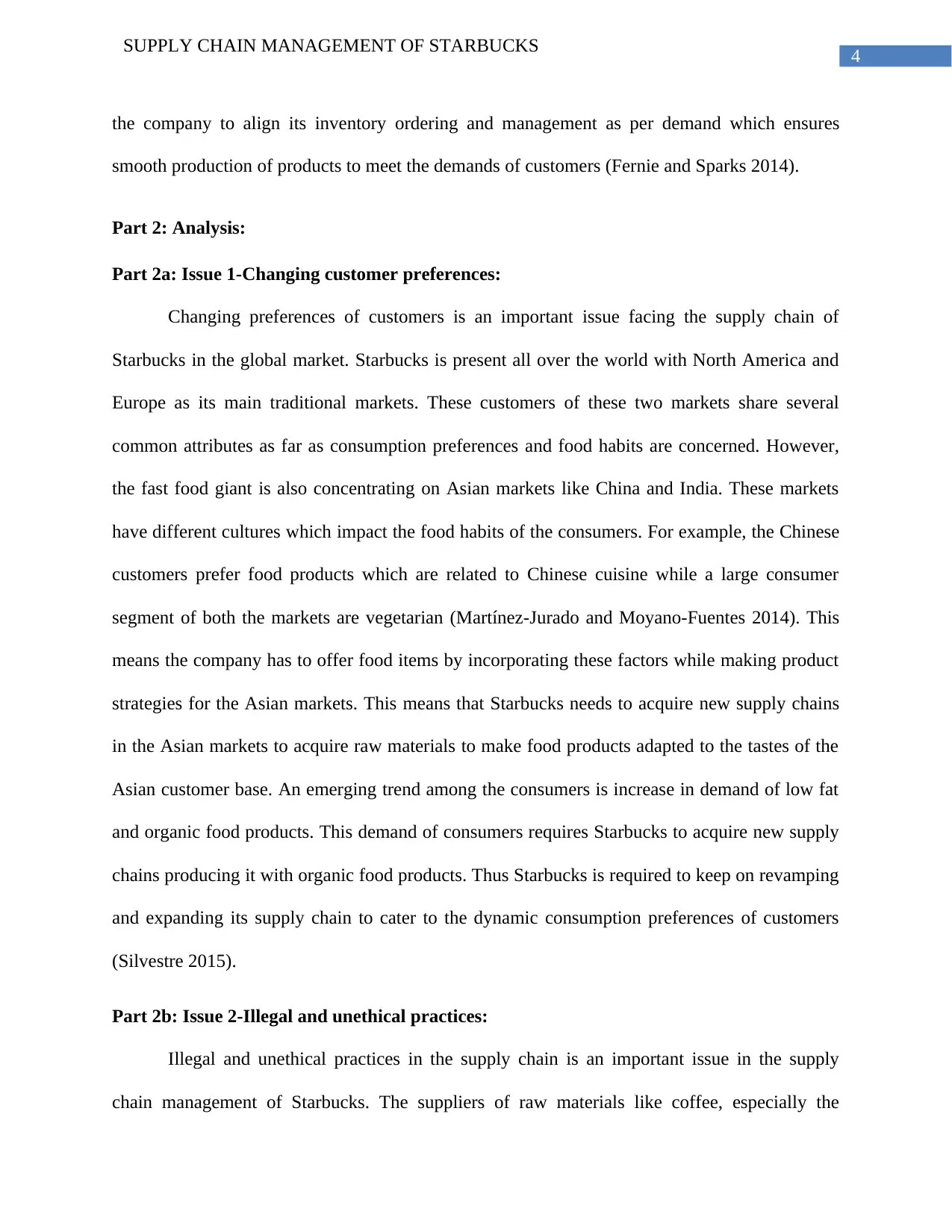
4
SUPPLY CHAIN MANAGEMENT OF STARBUCKS
the company to align its inventory ordering and management as per demand which ensures
smooth production of products to meet the demands of customers (Fernie and Sparks 2014).
Part 2: Analysis:
Part 2a: Issue 1-Changing customer preferences:
Changing preferences of customers is an important issue facing the supply chain of
Starbucks in the global market. Starbucks is present all over the world with North America and
Europe as its main traditional markets. These customers of these two markets share several
common attributes as far as consumption preferences and food habits are concerned. However,
the fast food giant is also concentrating on Asian markets like China and India. These markets
have different cultures which impact the food habits of the consumers. For example, the Chinese
customers prefer food products which are related to Chinese cuisine while a large consumer
segment of both the markets are vegetarian (Martínez-Jurado and Moyano-Fuentes 2014). This
means the company has to offer food items by incorporating these factors while making product
strategies for the Asian markets. This means that Starbucks needs to acquire new supply chains
in the Asian markets to acquire raw materials to make food products adapted to the tastes of the
Asian customer base. An emerging trend among the consumers is increase in demand of low fat
and organic food products. This demand of consumers requires Starbucks to acquire new supply
chains producing it with organic food products. Thus Starbucks is required to keep on revamping
and expanding its supply chain to cater to the dynamic consumption preferences of customers
(Silvestre 2015).
Part 2b: Issue 2-Illegal and unethical practices:
Illegal and unethical practices in the supply chain is an important issue in the supply
chain management of Starbucks. The suppliers of raw materials like coffee, especially the
SUPPLY CHAIN MANAGEMENT OF STARBUCKS
the company to align its inventory ordering and management as per demand which ensures
smooth production of products to meet the demands of customers (Fernie and Sparks 2014).
Part 2: Analysis:
Part 2a: Issue 1-Changing customer preferences:
Changing preferences of customers is an important issue facing the supply chain of
Starbucks in the global market. Starbucks is present all over the world with North America and
Europe as its main traditional markets. These customers of these two markets share several
common attributes as far as consumption preferences and food habits are concerned. However,
the fast food giant is also concentrating on Asian markets like China and India. These markets
have different cultures which impact the food habits of the consumers. For example, the Chinese
customers prefer food products which are related to Chinese cuisine while a large consumer
segment of both the markets are vegetarian (Martínez-Jurado and Moyano-Fuentes 2014). This
means the company has to offer food items by incorporating these factors while making product
strategies for the Asian markets. This means that Starbucks needs to acquire new supply chains
in the Asian markets to acquire raw materials to make food products adapted to the tastes of the
Asian customer base. An emerging trend among the consumers is increase in demand of low fat
and organic food products. This demand of consumers requires Starbucks to acquire new supply
chains producing it with organic food products. Thus Starbucks is required to keep on revamping
and expanding its supply chain to cater to the dynamic consumption preferences of customers
(Silvestre 2015).
Part 2b: Issue 2-Illegal and unethical practices:
Illegal and unethical practices in the supply chain is an important issue in the supply
chain management of Starbucks. The suppliers of raw materials like coffee, especially the
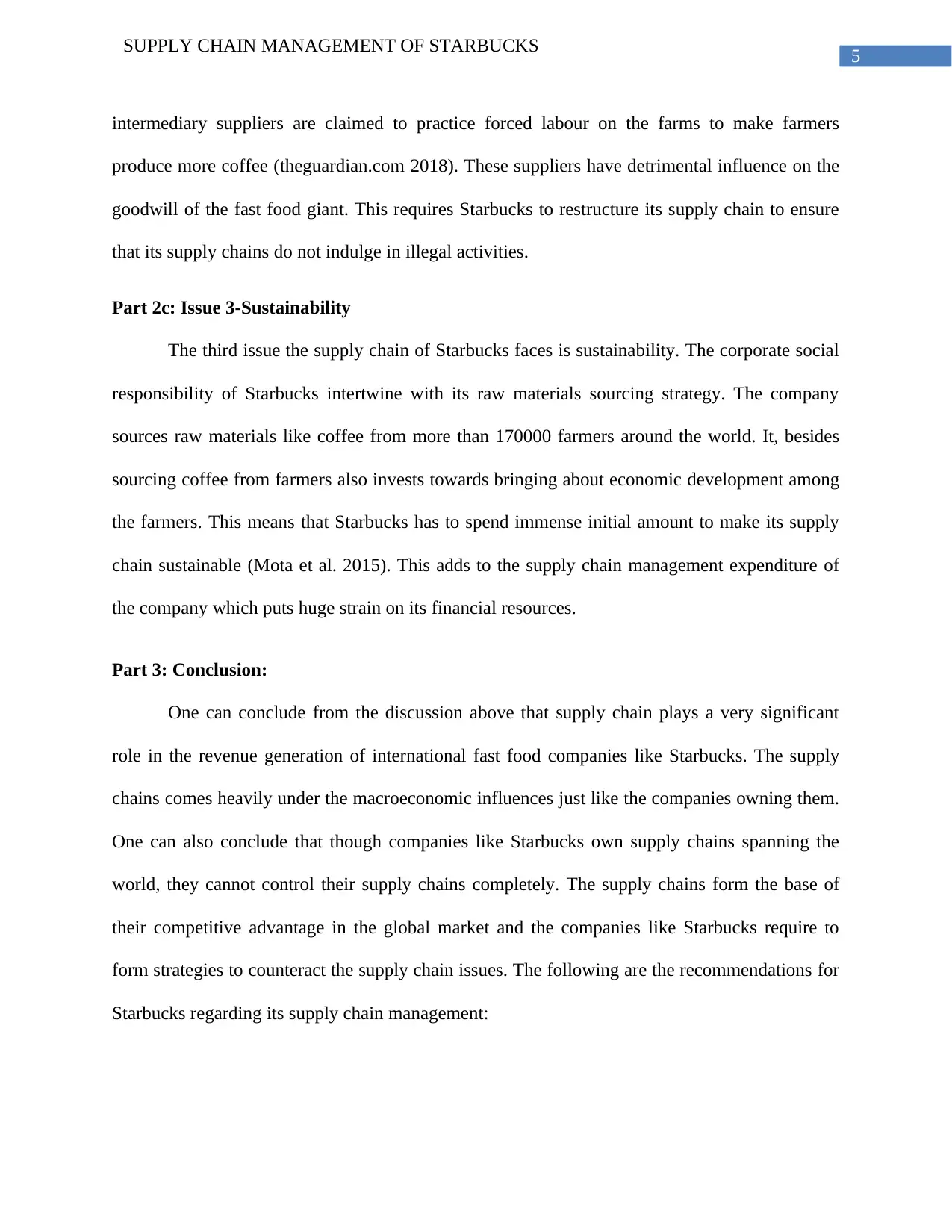
5
SUPPLY CHAIN MANAGEMENT OF STARBUCKS
intermediary suppliers are claimed to practice forced labour on the farms to make farmers
produce more coffee (theguardian.com 2018). These suppliers have detrimental influence on the
goodwill of the fast food giant. This requires Starbucks to restructure its supply chain to ensure
that its supply chains do not indulge in illegal activities.
Part 2c: Issue 3-Sustainability
The third issue the supply chain of Starbucks faces is sustainability. The corporate social
responsibility of Starbucks intertwine with its raw materials sourcing strategy. The company
sources raw materials like coffee from more than 170000 farmers around the world. It, besides
sourcing coffee from farmers also invests towards bringing about economic development among
the farmers. This means that Starbucks has to spend immense initial amount to make its supply
chain sustainable (Mota et al. 2015). This adds to the supply chain management expenditure of
the company which puts huge strain on its financial resources.
Part 3: Conclusion:
One can conclude from the discussion above that supply chain plays a very significant
role in the revenue generation of international fast food companies like Starbucks. The supply
chains comes heavily under the macroeconomic influences just like the companies owning them.
One can also conclude that though companies like Starbucks own supply chains spanning the
world, they cannot control their supply chains completely. The supply chains form the base of
their competitive advantage in the global market and the companies like Starbucks require to
form strategies to counteract the supply chain issues. The following are the recommendations for
Starbucks regarding its supply chain management:
SUPPLY CHAIN MANAGEMENT OF STARBUCKS
intermediary suppliers are claimed to practice forced labour on the farms to make farmers
produce more coffee (theguardian.com 2018). These suppliers have detrimental influence on the
goodwill of the fast food giant. This requires Starbucks to restructure its supply chain to ensure
that its supply chains do not indulge in illegal activities.
Part 2c: Issue 3-Sustainability
The third issue the supply chain of Starbucks faces is sustainability. The corporate social
responsibility of Starbucks intertwine with its raw materials sourcing strategy. The company
sources raw materials like coffee from more than 170000 farmers around the world. It, besides
sourcing coffee from farmers also invests towards bringing about economic development among
the farmers. This means that Starbucks has to spend immense initial amount to make its supply
chain sustainable (Mota et al. 2015). This adds to the supply chain management expenditure of
the company which puts huge strain on its financial resources.
Part 3: Conclusion:
One can conclude from the discussion above that supply chain plays a very significant
role in the revenue generation of international fast food companies like Starbucks. The supply
chains comes heavily under the macroeconomic influences just like the companies owning them.
One can also conclude that though companies like Starbucks own supply chains spanning the
world, they cannot control their supply chains completely. The supply chains form the base of
their competitive advantage in the global market and the companies like Starbucks require to
form strategies to counteract the supply chain issues. The following are the recommendations for
Starbucks regarding its supply chain management:
⊘ This is a preview!⊘
Do you want full access?
Subscribe today to unlock all pages.

Trusted by 1+ million students worldwide
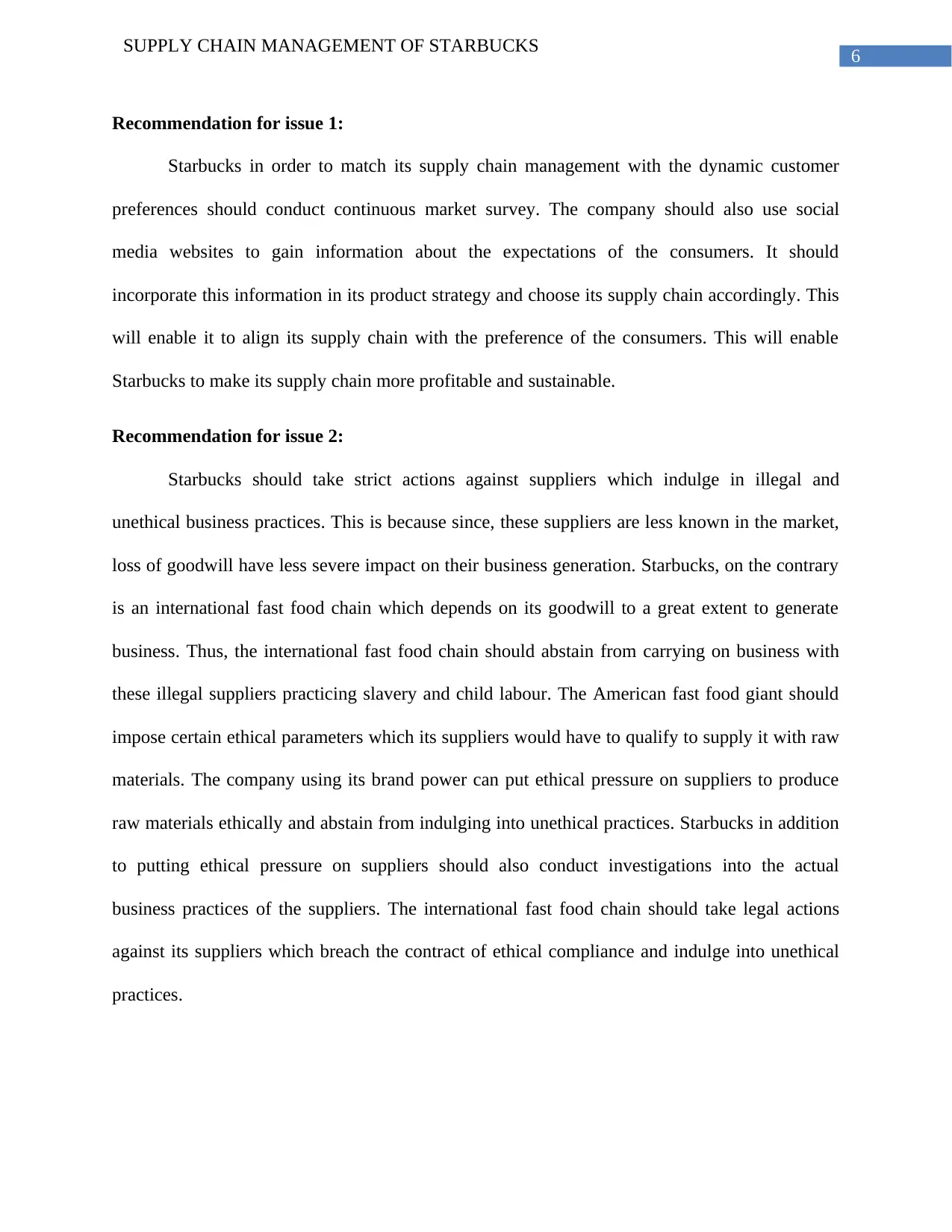
6
SUPPLY CHAIN MANAGEMENT OF STARBUCKS
Recommendation for issue 1:
Starbucks in order to match its supply chain management with the dynamic customer
preferences should conduct continuous market survey. The company should also use social
media websites to gain information about the expectations of the consumers. It should
incorporate this information in its product strategy and choose its supply chain accordingly. This
will enable it to align its supply chain with the preference of the consumers. This will enable
Starbucks to make its supply chain more profitable and sustainable.
Recommendation for issue 2:
Starbucks should take strict actions against suppliers which indulge in illegal and
unethical business practices. This is because since, these suppliers are less known in the market,
loss of goodwill have less severe impact on their business generation. Starbucks, on the contrary
is an international fast food chain which depends on its goodwill to a great extent to generate
business. Thus, the international fast food chain should abstain from carrying on business with
these illegal suppliers practicing slavery and child labour. The American fast food giant should
impose certain ethical parameters which its suppliers would have to qualify to supply it with raw
materials. The company using its brand power can put ethical pressure on suppliers to produce
raw materials ethically and abstain from indulging into unethical practices. Starbucks in addition
to putting ethical pressure on suppliers should also conduct investigations into the actual
business practices of the suppliers. The international fast food chain should take legal actions
against its suppliers which breach the contract of ethical compliance and indulge into unethical
practices.
SUPPLY CHAIN MANAGEMENT OF STARBUCKS
Recommendation for issue 1:
Starbucks in order to match its supply chain management with the dynamic customer
preferences should conduct continuous market survey. The company should also use social
media websites to gain information about the expectations of the consumers. It should
incorporate this information in its product strategy and choose its supply chain accordingly. This
will enable it to align its supply chain with the preference of the consumers. This will enable
Starbucks to make its supply chain more profitable and sustainable.
Recommendation for issue 2:
Starbucks should take strict actions against suppliers which indulge in illegal and
unethical business practices. This is because since, these suppliers are less known in the market,
loss of goodwill have less severe impact on their business generation. Starbucks, on the contrary
is an international fast food chain which depends on its goodwill to a great extent to generate
business. Thus, the international fast food chain should abstain from carrying on business with
these illegal suppliers practicing slavery and child labour. The American fast food giant should
impose certain ethical parameters which its suppliers would have to qualify to supply it with raw
materials. The company using its brand power can put ethical pressure on suppliers to produce
raw materials ethically and abstain from indulging into unethical practices. Starbucks in addition
to putting ethical pressure on suppliers should also conduct investigations into the actual
business practices of the suppliers. The international fast food chain should take legal actions
against its suppliers which breach the contract of ethical compliance and indulge into unethical
practices.
Paraphrase This Document
Need a fresh take? Get an instant paraphrase of this document with our AI Paraphraser
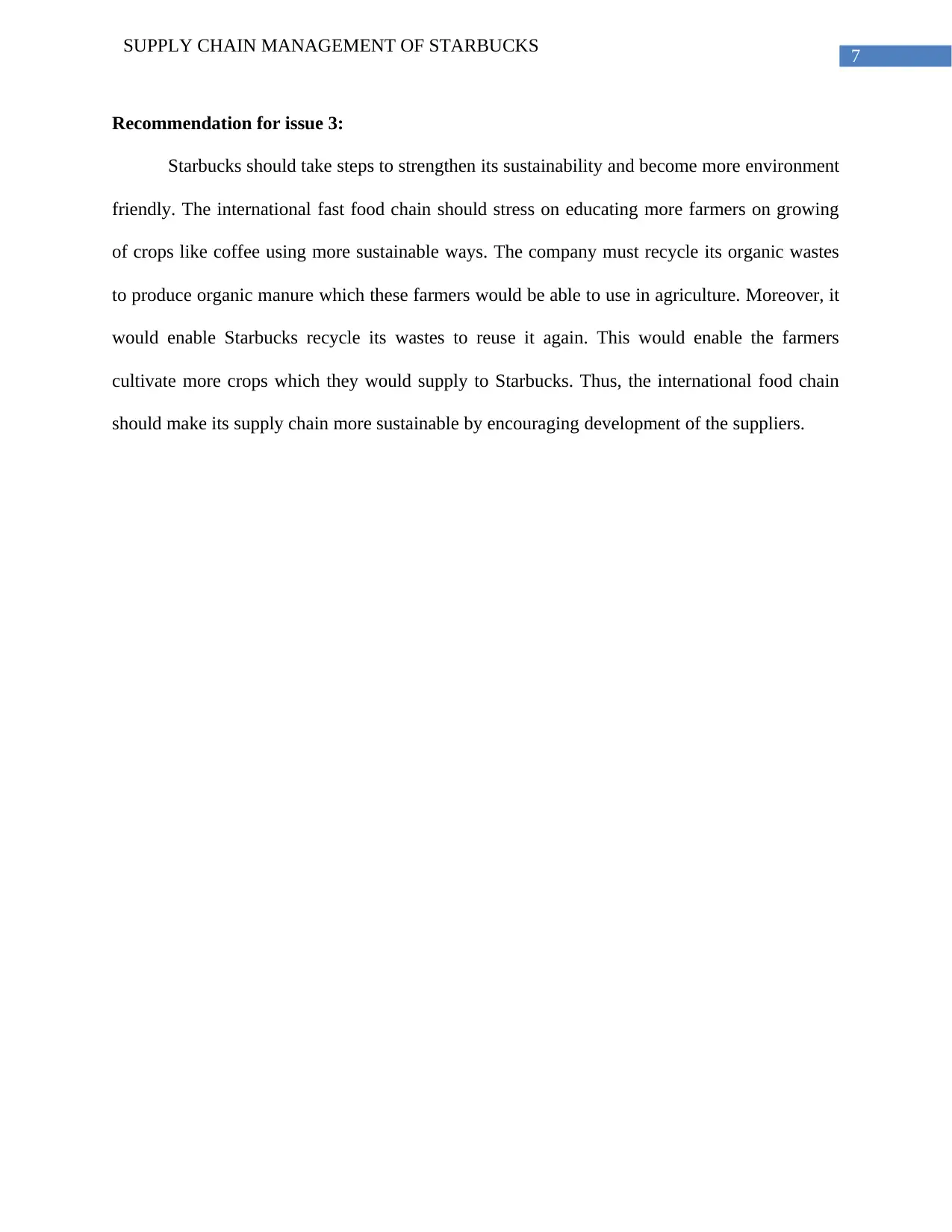
7
SUPPLY CHAIN MANAGEMENT OF STARBUCKS
Recommendation for issue 3:
Starbucks should take steps to strengthen its sustainability and become more environment
friendly. The international fast food chain should stress on educating more farmers on growing
of crops like coffee using more sustainable ways. The company must recycle its organic wastes
to produce organic manure which these farmers would be able to use in agriculture. Moreover, it
would enable Starbucks recycle its wastes to reuse it again. This would enable the farmers
cultivate more crops which they would supply to Starbucks. Thus, the international food chain
should make its supply chain more sustainable by encouraging development of the suppliers.
SUPPLY CHAIN MANAGEMENT OF STARBUCKS
Recommendation for issue 3:
Starbucks should take steps to strengthen its sustainability and become more environment
friendly. The international fast food chain should stress on educating more farmers on growing
of crops like coffee using more sustainable ways. The company must recycle its organic wastes
to produce organic manure which these farmers would be able to use in agriculture. Moreover, it
would enable Starbucks recycle its wastes to reuse it again. This would enable the farmers
cultivate more crops which they would supply to Starbucks. Thus, the international food chain
should make its supply chain more sustainable by encouraging development of the suppliers.
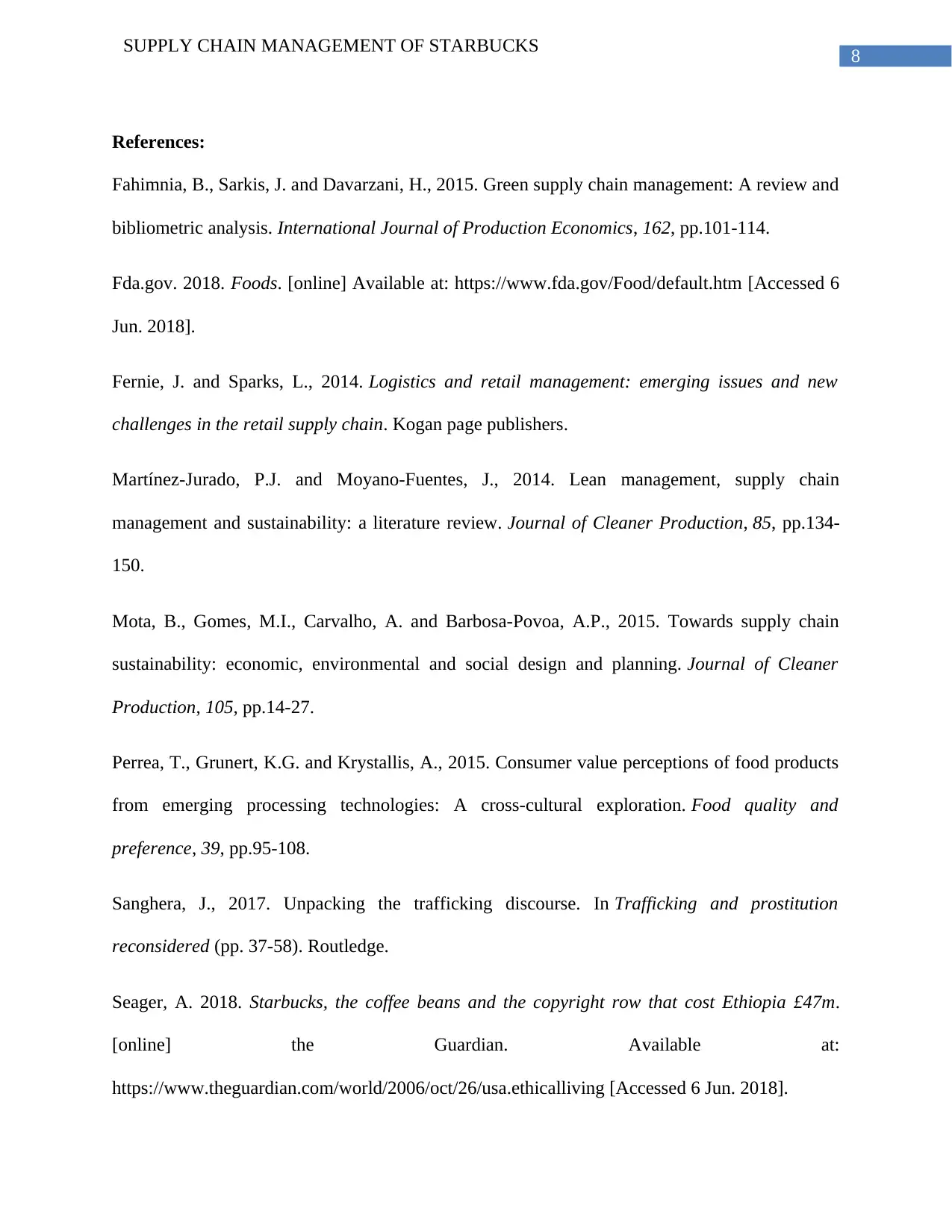
8
SUPPLY CHAIN MANAGEMENT OF STARBUCKS
References:
Fahimnia, B., Sarkis, J. and Davarzani, H., 2015. Green supply chain management: A review and
bibliometric analysis. International Journal of Production Economics, 162, pp.101-114.
Fda.gov. 2018. Foods. [online] Available at: https://www.fda.gov/Food/default.htm [Accessed 6
Jun. 2018].
Fernie, J. and Sparks, L., 2014. Logistics and retail management: emerging issues and new
challenges in the retail supply chain. Kogan page publishers.
Martínez-Jurado, P.J. and Moyano-Fuentes, J., 2014. Lean management, supply chain
management and sustainability: a literature review. Journal of Cleaner Production, 85, pp.134-
150.
Mota, B., Gomes, M.I., Carvalho, A. and Barbosa-Povoa, A.P., 2015. Towards supply chain
sustainability: economic, environmental and social design and planning. Journal of Cleaner
Production, 105, pp.14-27.
Perrea, T., Grunert, K.G. and Krystallis, A., 2015. Consumer value perceptions of food products
from emerging processing technologies: A cross-cultural exploration. Food quality and
preference, 39, pp.95-108.
Sanghera, J., 2017. Unpacking the trafficking discourse. In Trafficking and prostitution
reconsidered (pp. 37-58). Routledge.
Seager, A. 2018. Starbucks, the coffee beans and the copyright row that cost Ethiopia £47m.
[online] the Guardian. Available at:
https://www.theguardian.com/world/2006/oct/26/usa.ethicalliving [Accessed 6 Jun. 2018].
SUPPLY CHAIN MANAGEMENT OF STARBUCKS
References:
Fahimnia, B., Sarkis, J. and Davarzani, H., 2015. Green supply chain management: A review and
bibliometric analysis. International Journal of Production Economics, 162, pp.101-114.
Fda.gov. 2018. Foods. [online] Available at: https://www.fda.gov/Food/default.htm [Accessed 6
Jun. 2018].
Fernie, J. and Sparks, L., 2014. Logistics and retail management: emerging issues and new
challenges in the retail supply chain. Kogan page publishers.
Martínez-Jurado, P.J. and Moyano-Fuentes, J., 2014. Lean management, supply chain
management and sustainability: a literature review. Journal of Cleaner Production, 85, pp.134-
150.
Mota, B., Gomes, M.I., Carvalho, A. and Barbosa-Povoa, A.P., 2015. Towards supply chain
sustainability: economic, environmental and social design and planning. Journal of Cleaner
Production, 105, pp.14-27.
Perrea, T., Grunert, K.G. and Krystallis, A., 2015. Consumer value perceptions of food products
from emerging processing technologies: A cross-cultural exploration. Food quality and
preference, 39, pp.95-108.
Sanghera, J., 2017. Unpacking the trafficking discourse. In Trafficking and prostitution
reconsidered (pp. 37-58). Routledge.
Seager, A. 2018. Starbucks, the coffee beans and the copyright row that cost Ethiopia £47m.
[online] the Guardian. Available at:
https://www.theguardian.com/world/2006/oct/26/usa.ethicalliving [Accessed 6 Jun. 2018].
⊘ This is a preview!⊘
Do you want full access?
Subscribe today to unlock all pages.

Trusted by 1+ million students worldwide
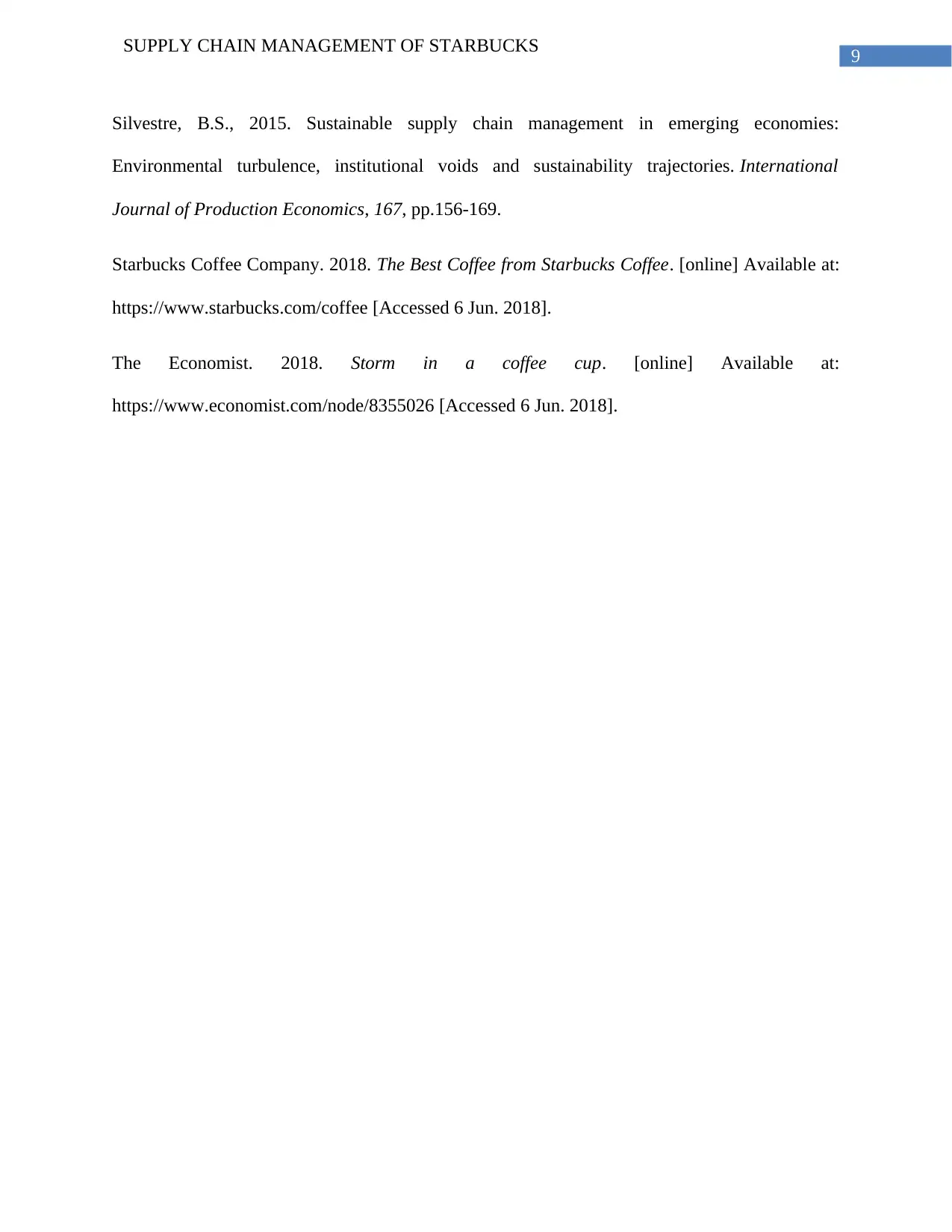
9
SUPPLY CHAIN MANAGEMENT OF STARBUCKS
Silvestre, B.S., 2015. Sustainable supply chain management in emerging economies:
Environmental turbulence, institutional voids and sustainability trajectories. International
Journal of Production Economics, 167, pp.156-169.
Starbucks Coffee Company. 2018. The Best Coffee from Starbucks Coffee. [online] Available at:
https://www.starbucks.com/coffee [Accessed 6 Jun. 2018].
The Economist. 2018. Storm in a coffee cup. [online] Available at:
https://www.economist.com/node/8355026 [Accessed 6 Jun. 2018].
SUPPLY CHAIN MANAGEMENT OF STARBUCKS
Silvestre, B.S., 2015. Sustainable supply chain management in emerging economies:
Environmental turbulence, institutional voids and sustainability trajectories. International
Journal of Production Economics, 167, pp.156-169.
Starbucks Coffee Company. 2018. The Best Coffee from Starbucks Coffee. [online] Available at:
https://www.starbucks.com/coffee [Accessed 6 Jun. 2018].
The Economist. 2018. Storm in a coffee cup. [online] Available at:
https://www.economist.com/node/8355026 [Accessed 6 Jun. 2018].
1 out of 10
Related Documents
Your All-in-One AI-Powered Toolkit for Academic Success.
+13062052269
info@desklib.com
Available 24*7 on WhatsApp / Email
![[object Object]](/_next/static/media/star-bottom.7253800d.svg)
Unlock your academic potential
Copyright © 2020–2025 A2Z Services. All Rights Reserved. Developed and managed by ZUCOL.





